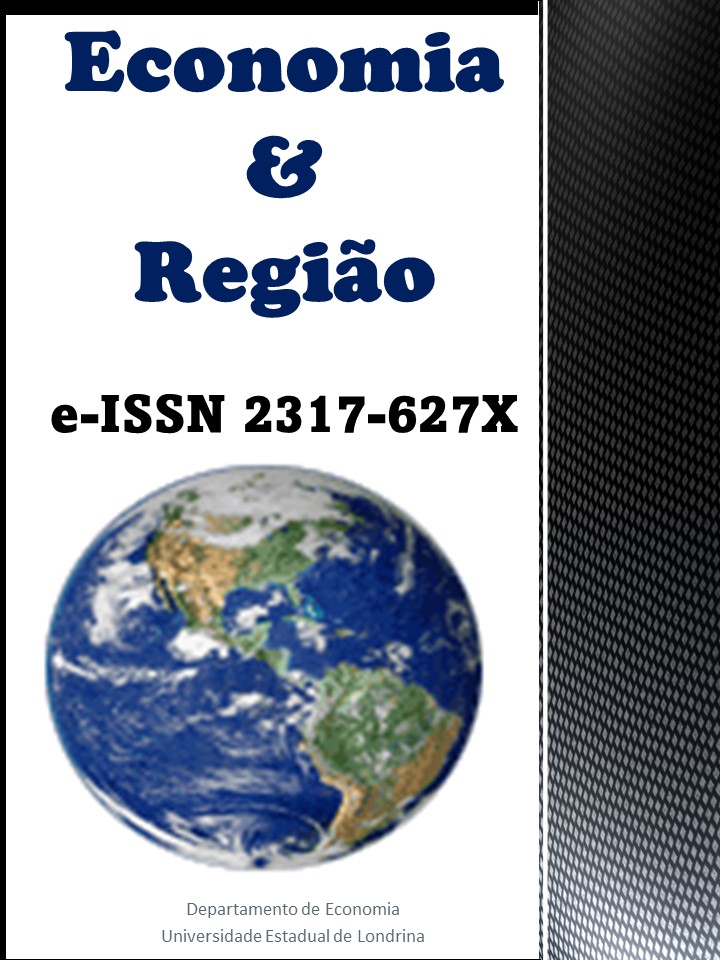Growth, investiment and pension scheme in Brazil : a Post-Keynesian approach
DOI:
https://doi.org/10.5433/2317-627X.2022v10n2p49Keywords:
Pension in Brazil, Post keynesianism, Pensions, Growth regime.Abstract
The objective of this research is to analyze the effects of pensions from the initial debate between the growth regimes (profit-led or wage-led) on the investment. It aims to answer the question about which growth pattern (influenced by profits or wages) is predominant in the Brazilian social security distribution model. The methodology consisted in the use of the concepts of post-Keynesian theory, making a historical section covering the period from 2003 to 2015. Thus employing a historical-deductive method, with a qualitative-quantitative approach, as well as employing data collection for the realization of econometric tests using the Ordinary Least Squares Method (OLS). The results showed that there is a strong sensitivity between the participation of pensions in the effective investment made by the Brazilian business community.Downloads
References
ARAÚJO, Eliane; GALA, Paulo. Regimes de crescimento econômico no Brasil: evidências empíricas e implicações de política. Estudos avançados, São Paulo, v. 26, n. 75, p. 41-56, 2012.
AMITRANO, C. R. Instituições, Distribuição de Renda e Crescimento Econômico: Uma Análise Pós-keynesiano: Brasília, DF: IPEA, 2016.
BARROS, R. P.; FOGUEL, M. N.; ULYSSEA, G. (Org.). Desigualdade de renda no Brasil: uma análise da queda recente. [S.l.: s.n.], 2006.
BHADURI, A.; MARGLIN, S. Unemployment and the real wage: the economic basis for contesting political ideologies. Cambridge journal of Economics, United Kingdom, v. 14, n. 4, p. 375-393, 1990.
CANO, W. Desequilíbrios regionais e concentração industrial no Brasil: 1930-1970. São Paulo: Global; Campinas: Unicamp, 1985.
CARVALHO, L. A valsa brasileira: do boom ao caos econômico. São Paulo: Todavia, 2018.
DE CARVALHO, Laura Barbosa; RUGITSKY, Fernando. Growth and distribution in Brazil the 21st century: revisiting the wage-led versus profit-led debate. FEA/USP, 2015.
ILES, R. A., D., M., Taylor, N. F.; O'H., P. Systematic review of the ability of recovery expectations to predict outcomes in non-chronic non-specific low back pain. Journal of occupational rehabilitation, United States, v. 19, n. 1, p. 25-40. 2009.
INSTITUTO DE PESQUISA ECONÔMICA APLICADA. Disponível em: http://www.ipeadata.gov.br. Acesso em: 9 out. 2019.
INSTITUTO BRASILEIRO DE GEOGRAFIA E ESTATÍSTICA. Disponível em: https://www.ibge.gov.br/. Acesso. 11. out. 2019.
GUJARATI, D. N.; PORTER, D. C. Basic econometrics. New York: McGraw-HiII, 2003.
HELENE, O. Metodos dos Minimos Quadrados. São Paulo: Livraria da Física, 2006.
KALECKI, M. Teoria da dinâmica econômica: ensaios sobre as mudanças cíclicas e a longo prazo da economia capitalista. São Paulo: Abril, 1954. (Série Os Economistas).
KALDOR, N. A model of the trade cycle. The Economic Journal, United Kingdom, v. 50, n. 19, p. 78-92, mar. 1940.
KEYNES, John Maynard. Teoria geral do emprego, do juro e da moeda. Editora Saraiva, 2017.
MEDEIROS, Carlos Aguiar de. A influência do salário mínimo sobre a taxa de salários no Brasil na última década. Economia e Sociedade, v. 24, n. 2, p. 263-292, 2015.
MINISTÉRIO DA ECONOMIA. SECRETARIA DE PREVIDÊNCIA. Disponível em: http://www.previdencia.gov.br/dados-abertos. Acesso em: 9 out. 2019.
OREIRO, J. L.; MARCONI, N. O novo-desenvolvimentismo e seus críticos. Cadernos do desenvolvimento, Rio de Janeiro, v. 11, n. 19, p. 167-179, 2016.
ONARAN, Özlem; GALANIS, Giorgos. Is aggregate demand wage-led or profit-led. National and global effects. ILO Conditions of Work and Employment Series, v. 31, n. 3, p. 1-51, 2012.
RADA, C. The economics of pensions: Remarks on growth, policy and class conflict. Working Paper, [S. l.], 2012.
SCHMIDT-HEBBEL, K.; SERVEN, L.; SOLIMANO, A. Savings and invest: paradigms, puzzles, polices.
The World Bank Research Observer, 1996.
SERRANO, F. Juros, câmbio e o sistema de metas de inflação no Brasil. Brazilian Journal of Political Economy, São Paulo, v. 30, n. 1, p. 63-72, 2010.
SICSÚ, J. Expectativas inflacionárias no regime de metas de inflação: uma análise preliminar do caso brasileiro. Economia aplicada, São Paulo, v. 6, n. 4, p. 703-711, 2002.
SIMONSEN, M. H. Keynes versus expectativas racionais. Pesquisa e planejamento Econômico, Rio de Janeiro, v. 16, n. 2, p. 251-262, ago. 1986.
STOCK, J. H. et al. Introduction to econometrics. Boston: Addison Wesley, 2003.
WRAY, L. R.; TYMOIGNE, E. Macroeconomics meets hyman p. minsky: the financial theory of investment. In: FONTANA, J.; SETTERFIELD, M. Macroeconomic theory and macroeconomic pedagogy. London: Palgrave Macmillan, 2009. p 234-251.
Downloads
Published
How to Cite
Issue
Section
License
Copyright (c) 2022 Economia & Região

This work is licensed under a Creative Commons Attribution 4.0 International License.
Economia & Região adota a Licença Creative Commons Attribution CC-BY 4.0 International, portanto, os direitos autorais relativos aos artigos publicados são do(s) autor(es), que cedem à Revista Economia & Região o direito de exclusividade de primeira publicação.
Sob essa licença é possível: Compartilhar - copiar e redistribuir o material em qualquer suporte ou formato. Adaptar - remixar, transformar, e criar a partir do material, atribuindo o devido crédito e prover um link para a licença e indicar se mudanças foram feitas.




















